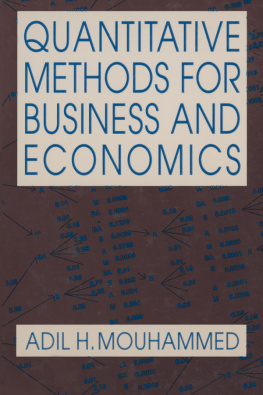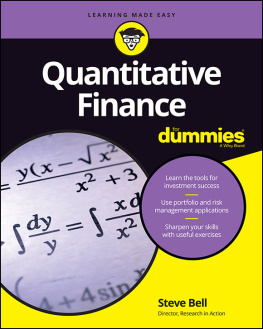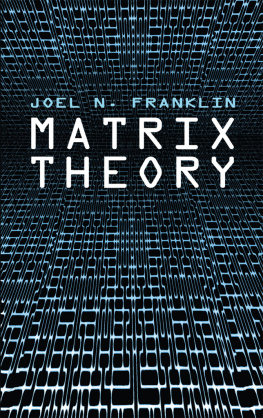QUANTITATIVE
METHODS FOR
BUSINESS AND
ECONOMICS
QUANTITATIVE
METHODS FOR
BUSINESS AND
ECONOMICS
ADIL H. MOUHAMMED
UNIVERSITY OF ILLINOIS
At SPRINGFIELD
First published 2000 by M.E. Sharpe
Published 2015 by Routledge
2 Park Square, Milton Park, Abingdon, Oxon 0X14 4RN
711 Third Avenue, New York, NY 10017, USA
Routledge is an imprint of the Taylor & Francis Group, an informa business
Copyright 2000 Taylor & Francis. All rights reserved.
No part of this book may be reprinted or reproduced or utilised in any form or by any electronic, mechanical, or other means, now known or hereafter invented, including photocopying and recording, or in any information storage or retrieval system, without permission in writing from the publishers.
Notices
No responsibility is assumed by the publisher for any injury and/or damage to persons or property as a matter of products liability, negligence or otherwise, or from any use of operation of any methods, products, instructions or ideas contained in the material herein.
Practitioners and researchers must always rely on their own experience and knowledge in evaluating and using any information, methods, compounds, or experiments described herein. In using such information or methods they should be mindful of their own safety and the safety of others, including parties for whom they have a professional responsibility.
Product or corporate names may be trademarks or registered trademarks, and are used only for identification and explanation without intent to infringe.
Library of Congress Cataloging-in-Publication Data
Mouhammed, Adil Hasan.
Quantitative methods for business and economics / Adil Mouhammed.
p. cm.
Includes bibliographical references and index.
ISBN 0-7656-0458-2 (alk. paper)
1. Economics, Mathematical. I. Title.
HD 135.M68 1999
ISBN 13: 9780765604583 (hbk)
Contents
The basic objective behind the writing of this book is to provide both students and individuals with a simple and rigorous introduction to various quantitative methods used in business and economics. It is a simple text because it does not need prerequisites other than high school algebra; it is rigorous because it is built on mathematical sophistication. In addition, the length of the text is relatively short so it can be used over one semester.
The book starts with matrix algebra. , the input-output model is outlined. Types I and II employment and income multipliers as well as sectoral prices are derived from the input-output model. The effects of incoming and outgoing industries are explained, and the total backward and forward linkages are measured.
In is devoted to the dynamic techniques used in business and economics. Integration, definite and indefinite, is introduced along with its application to various economic and business problems such as consumer and producer surplus and the present value of a financial sum. In addition, first- and second-order linear difference equations are introduced, with several economic applications such as the Domar and Harrod models of economic growth and the Cobweb price model. Similarly, the first- and second-order differential equations are introduced with various economic applications.
is devoted to sensitivity analysis, range analysis, and duality. An appendix in this chapter tackles issues such as free variable, dual-simplex method, two-phase method of solution, and other issues.
In is devoted to the analysis of Markov chains. States, stages, and transitional probabilities are presented. Once these concepts are understood, the chapter explains the steady-state probabilities and the absorbing and nonabsorbing states. In addition, the fundamental matrix and some business applications are provided.
introduces the general linear model. This chapter can be considered as an introductory foundation to econometrics. The general linear model is used to measure economic relationships and test economic propositions. Estimation and hypothesis testing are provided as well as the coefficient of determination, R2, and the adjusted R2. In addition, forecasting and confidence intervals for the predicted values are furnished. Various business and economic applications are provided at the end of the chapter.
As can be seen, this text will not only provide users with knowledge in mathematical analysis and its application to business and economics, but students will also understand several quantitative models such as inventory analysis, input-output model, decision theory, Markov chains, and so forth. Put differently, I have attempted to provide readers with the basic techniques they can utilize in solving real-world problems. Also, my aim is to have readers interested in quantitative methods establish an excellent background to go further in acquiring more knowledge in this field.
This book can be used as an introductory text in quantitative methods for junior and senior students, and can also serve as a reference bookdo it your own wayfor MBA students who lack a solid background in quantitative techniques. In addition, the text is very helpful for a course in managerial economics, where students need to know topics such as differentiation with applications to business and economics, optimization, linear programming, regression analysis, and decision theory.
Springfield, Illinois
Fall 1999
In writing Quantitative Methods for Business and Economics, I am indebted to various individuals. First, I thank the previous dean of the School of Business and Management, Sangamon State University, John Nosari, for giving me release time necessary to finish the writing of the text. Given the various courses I teach each academic year, that release time was important, for without it I could not have completed the book. Also, I have been using some chapters of this book in a course entitled Quantitative Methods for Business and Economics since 1990.1 have received very important feedback from the students who took that course. In addition, my children, Mouhammed and Hayder, have helped me in shaping the book into its final form. Moreover, I received some typing support from Marilynn Mooney secretary in the Department of Economics at the University of Illinois at Springfield. Finally, I appreciate the help and encouragement I received from my wife, Majda Salman, and some of my colleagues at the University of Illinois at Springfield, in particular David Olson, Leonard Branson, and Bonnie Moe of the Department of Accountancy. Any errors are mine.
Vectors and matrices are very important tools in economic analysis. This chapter outlines the algebra of vectors. Students will not only be able to add and subtract vectors but also to multiply vectors. For economic modeling, linear independence is indispensable in that economic models must have unique solutions, and linear independence provides these solutions. Similarly, linear and convex combinations are also important for economics.
An extension of vector analysis is matrix algebra. The types of matrices and matrix operations are outlined in this chapter. A system of equations is solved by using matrix methods such as the inverse method, Cramers rule and the Gauss-Jordan method. Eigenvalues and vectors are explained and used for diagonalizing matrices. Finally, various economic applications of matrices are provided.
A vector is a symbol used to refer to a set of variables or coefficients. For example,
Next page






